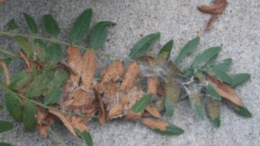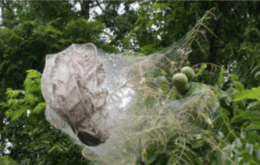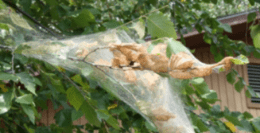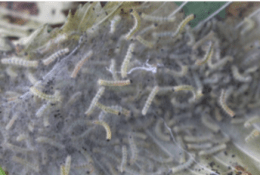By Raymond Cloyd, Professor and Extension Specialist
Mimosa Webworm
Damage associated with mimosa webworm, Homadaula anisocentra, larvae/caterpillars is quite noticeable on honey locust, Gleditsia triacanthos, and mimosa, Albizia julibrissin, trees throughout Kansas.

The larvae/caterpillars are 1/2 of an inch long when full–grown and move backward rapidly when disturbed.
Caterpillars’ web leaves together on the ends of branches. Webbing typically starts at the tops of trees and protects caterpillars from natural enemies (parasitoids and predators) and insecticide spray applications.

Heavily infested trees are brown or scorched in appearance because the caterpillars skeletonize the leaf tissue. Caterpillars eventually leave trees using a silken strand before pupating. Mimosa webworm pupates in bark crevices or pupae are attached to structures (e.g. buildings). There are two generations per year in Kansas.

It is too late to apply an insecticide this time of year when trees are heavily infested with webbing because the caterpillars are protected from insecticide spray applications inside the leaf webbing. However, next year, you can manage mimosa webworm caterpillar populations by applying an insecticide when the caterpillars are initially present and exposed to insecticide spray applications.
You can use insecticides that contain the following active ingredients: Bacillus
thuringiensis subsp. kurstaki, spinosad, bifenthrin, cyfluthrin, and permethrin. Read the label of each product to ensure that “webworms” are listed. Bacillus thuringiensis subsp. kurstaki and spinosad are stomach poisons so mimosa webworm caterpillars are killed after ingesting the spray solution on the leaf surface. High-volume spray applications are required so that the insecticide contacts the caterpillars or there are residues on the leaf surface.
Selective pruning, if possible, can quickly remove isolated or localized early infestations of mimosa webworm.
Fall Webworm
The fall webworm, Hyphantria cunea, second generation is now present throughout most of Kansas with nests present on trees, such as, hickory and walnut.

Fall webworm nests consists of silk webbing that encloses the ends of branches and leaves. Fall webworm larvae or caterpillars are pale-green, yellow to nearly white, with two black spots on each abdominal segment. Caterpillars are covered with long, white hairs.

Fall webworm caterpillars feed on a wide-range of trees, including: birch, cherry, crabapple, elm, maples, hickory, pecan, mulberry, walnut, and willow. Fall webworm caterpillars, unlike caterpillars associated with the eastern tent caterpillar, Malacosoma americanum, remain within the enclosed nests and do not venture out to feed.

Caterpillars consume leaves, resulting in branches with only webbing attached that contains fecal deposits (frass) or ‘caterpillar poop’. The nests will eventually dry-up as the caterpillars transition into pupae, with adults eventually eclosing (emerging) from the pupae later on in the growing season.
At this time of year, feeding by fall webworm caterpillars is not directly harmful to trees, especially larger trees. The most effective method of managing fall webworm infestations is to prune-out the nests that enclose the caterpillars, place into a plastic bag, and dispose of immediately. Insecticide spray applications are not be effective in managing fall webworm infestations because the caterpillars remain in the nests while feeding, which reduces exposure to spray residues. If insecticides need to be applied, for whatever reason, use high-volume spray applications that penetrate the protective nests, or use a rake to disrupt or open-up the nests so that insecticide sprays contact the caterpillars.
Articles originated from the Kansas State University Extension Entomology Newsletter
